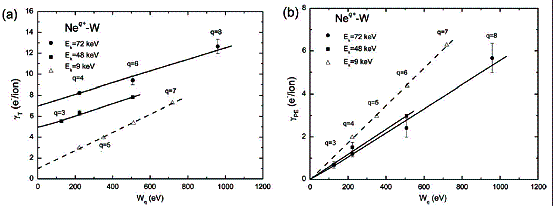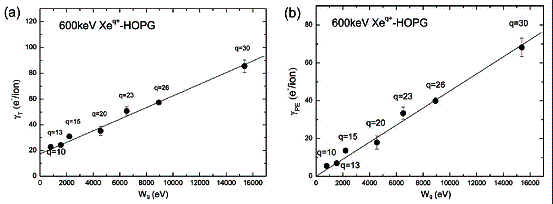Researchers in Institute of Modern Physics, Chinese Academy of Sciences (IMP) made progress in the research of electron emission on fusion-relevant tungsten and graphite surfaces induced by highly charged neon and xenon ions. The secondary electron yields were measuredat the surface physics terminal of the 320kV ECRIS Platform at IMP. From the experimental results, the contributions of the kinetic electron yield and the potential electron yield was separated.
Total electron emission yield  as a function of available potential energy
as a function of available potential energy  of the incident ions for normal impact of 40Neq+ (q = 3-8) on W and 129Xeq+ (q = 10-30) on HOPG are shown in Fig. (1a) and (2a). For a given impact energy the data points lie along a linear line and these lines are shifted to larger
of the incident ions for normal impact of 40Neq+ (q = 3-8) on W and 129Xeq+ (q = 10-30) on HOPG are shown in Fig. (1a) and (2a). For a given impact energy the data points lie along a linear line and these lines are shifted to larger  values for higher projectile energies, indicating that contribution of kinetic electron emission can be estimated from the data. The “pure” potential electron emission yields γPE obtained after subtracting the evaluated
values for higher projectile energies, indicating that contribution of kinetic electron emission can be estimated from the data. The “pure” potential electron emission yields γPE obtained after subtracting the evaluated  values are plotted versus
values are plotted versus  in Figs. (1b) and (2b) respectively. γPE can be approximated as:
in Figs. (1b) and (2b) respectively. γPE can be approximated as: 
The fraction of ion’s potential energy for potential electron emission  is given as:
is given as:

The values of k and  for various ion-target combinations and ion impact energies obtained from Fig. (1b) and (2b) are given in Table 1. Roughly 10% of the potential energy is consumed in potential electron emission.
for various ion-target combinations and ion impact energies obtained from Fig. (1b) and (2b) are given in Table 1. Roughly 10% of the potential energy is consumed in potential electron emission.
The result has been published in Nuclear Instruments and Methods in Physics Research B 269 (2011) 977-980.

Fig. 1. (a) Total secondary electron yield as a function of available potential energy for Neq+ impact of W. (b) True potential electron yield as a function of available potential energy for Neq+ impact of W.(Image by IMP)

Fig. 2. (a) Total electron yield as a function of available potential energy ofXeq+ impact onHOPG. (b) True potential electron yield as a function of available potential energy ofXeq+ impact onHOPG. (Image by IMP)

(Image by IMP)

